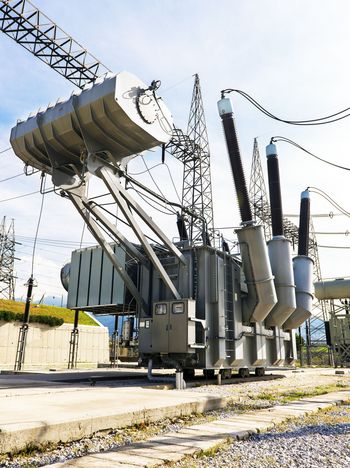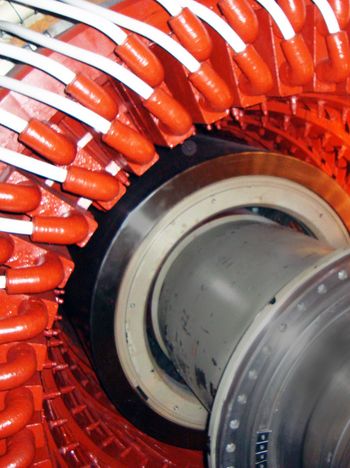Transmission and distribution equipment
By Nenad Uzelac, Chair, and Frank Richter, Secretary
The year 2021 was the second year that was marked by the Corona pandemic. It was supposed to be a year with many personal contacts after the contact restrictions in 2020. As highlight the centennial CIGRE session in Paris was planned. However, we learned again that people, who are actually close, could be very far away and people who are usually far away could be very close. Nevertheless, due to the now standard handling of the tools for online meetings, the work could be continued and the highlights of CIGRE SC A3 in the second year of limited face-to-face contacts will be reported here.
Despite all the limitations, the highlight was of course the CIGRE centennial session in Paris. The format of a live broadcast moderated from Paris with many online participants made the meeting and discussion very lively. For SC A3 the two weeks of CIGRE centennial session started with a tutorial on MV and HV DC circuit breakers on the 19th of August 2021. The convenors and members of WG A3.40 and B4/A3.80 did the tutorial. More than 160 participants listened to the state of the art and the latest trends. The second highlight and one of the most participated during the session was the workshop on SF6 gas alternatives. A3 in conjunction with B3 and D1 led the workshop. Over 220 participants were present showing that the environmental impact of the insulating and interrupting media of T&D equipment is a hot topic, if not the hottest topic now. As final event of the SC A3 organised events the group discussion took place over two days (26. and 27.08.20210). The same and updated papers as submitted in 2020 were discussed, but here again under the cover of a Special report. Around 120 participants were present at each of the days. 31 prepared contribution, one presentation from the next generation network and 3 expert keynotes were presented. The technical discussions that developed around the prepared contribution as answers on the questions of the special reporters were at a high level.
Despite all efforts and precise preparations, there were fewer participants in the events than in previous years. When investigating the causes, the lower participation was pointed out, that the session was less attractive. The people explained not having the possibility to meet others for discussions, networking and the missing exhibition with new product presentation, which may also trigger opinion exchange and confrontation, is a big disadvantage. Furthermore the discussed papers were nearly still the same from 2020 session and live presentations were appreciated instead of pre-recorded ones. The interactivity is limited in comparison to a normal session, since the attendees can only put questions in a written form in the chat rooms.
The second highlight was the CIGRE Symposium in Ljubljana, which was held from the 21st to 24th of November 2021. It was conducted as a hybrid event. It was possible to participate in person as well as online. The topic of the Symposium was “Reshaping the Electric Power System Infrastructure” with 3 main topics: a) Structural changes of existing equipment and infrastructure, b) New equipment and infrastructure and C) Security of the network. 10 technical committees participated, including SC A3 with eight papers. SC A3 conducted a tutorial on “Innovation and Trends in T&D equipment”. Although the physical attendance was much lower than anticipated due to COVID, after two years of virtual events it was great to see people in person!
The SC meeting was held in conjunction with the Symposium in Ljubljana. The event was divided into 2 days (November 25th and 26th) to allow all participants to participate at normal times due to the time differences between the locations of the individual participants. Here the status of the work, future projects, topics of working groups and the next events were discussed.
The technological field of activity of SC A3 remains the same as in the past year and reflects the strategic 3D – Decentralisation, Decarbonisation and Digtalisation - objectives as follows:.
- Innovative design and technologies (e.g. DC circuit breakers, SF6 free technologies)
- Requirements for equipment in changing network conditions and environmental conditions (e.g. offshore applications, adverse weather conditions)
- Incorporation of intelligence into T&D equipment (e.g. controlled switching, low power instrument transformers, digital twin technology, edge computing)
- Monitoring and diagnostics of T&D equipment (e.g. transition to non-intrusive technologies)
- New and improving testing techniques (e.g. superimposed test technics for HVDC equipment)
- Reliability assessment and lifetime management of ageing equipment
- New designs and additional requirements in T&D equipment (e.g. generator circuit breakers, fault current limiters, fast acting switchgear)
The structure (refer to picture 1) of the study committee remains unchanged. By the structure, SC A3 shall be able to identify and react quickly to trends and problems and to set up and complete working groups very fast.

Figure 1 - Structure of the Study Committee SC A3
The utility advisory board (UAB) that was formed in 2020, and proceeded its work in 2021.
Meanwhile, 24 utilities from 14 countries participated in the fourth CIGRE reliability survey on equipment such as circuit breakers (CB), disconnecting switches (DS) earthing switches (ES) and gas insulated switchgear (GIS) with the voltage ratings higher than or equal to 60 kV. The scope of the survey on instrumental transformers (IT) and metal oxide surge arresters (MOSA) covers the applications in conjunction with HV switching equipment. The survey also attempts to investigate HV and MV vacuum interrupters (VCB) and generator circuit breakers (GCB). The major failure frequency of CB and GIS generally shows lower failure rates than those in the third survey. However, the background CB populations are significantly compared to the previous surveys due to new participants with large installations. SC A3 will establish a new WG and update the reliability statistics on different equipment at the earliest opportunity.
In 2021 all the current Working Group (WG)/ Joint Working Group (JWG) activities related to SC A3 are listed in the table below.
Working Groups led by SC A3
| WG A3.31 Finished in 2021 | Non-conventional instrument transformers | F. Rahmatian (CA) |
| WG A3.36 Finished in 2021 | Simulation for temperature rise test | M. Kriegel (CH) |
| WG A3.39 | Field Experience of Surge Arresters | R. Le Roux (IL) |
| WG A3.40 | Technical Requirements and Testing Recommendations for MV DC switching equipment at distribution levels | C. Heinrich (DE) |
| WG A3.41 | Interrupting and switching performance with SF6 free switching equipment | R. Smeets (NL) |
| WG A3.42 | Failure analysis and risk mitigation for recent incidents of AIS instrument transformers | H. J. A. Martins (BR) |
| WG A3.43 | Tools for lifecycle management of T&D switchgear based on data from condition monitoring systems | N. Gariboldi (CH) |
| JWG A3 /A2/A1/B1.44 | Consequence of High Voltage Equipment operating exceeding highest system voltages | B. Rusek (GE) |
| WG A3.45 | Methods for identification of frequency response characteristic of voltage measurement systems | E. Sperling (CH) |
| WG A3.46 | Generator Circuit-Breakers: review of application requirements, practices, in-service experience and future trends | P. Novak (GE) |
| WG A3.47 New established in 2021 | Lifetime Management of Medium Voltage Indoor Switchgear | A. Maheshwari (AU) |
Joint Working Groups led by other SC with active participation of SCA3
| JWG B4/A3.80 | HVDC Circuit Breakers - Technical Requirements, Stresses and Testing Methods to investigate the interaction with the system | J. Cao (CN) |
| JWG B4/A3 86 | Fault Current Limiting Technologies for DC Grids | Z. He (CN) |
| JWG C4/A3.53 | Application Effects of Low-Residual-Voltage Surge Arresters in Suppressing Overvoltages in UHV AC Systems | J. He (CN) |
| JWG B3/A3.59 | Guidelines for SF6 end-of-life treatment of T&D equipment (>1kV) in Substations | Maik Hyrenbach (DE) |
| JWG B3/A3.60 New established in 2021 | User guide for non-SF6 gases and gas mixtures in Substations | K.P. (Piet) Knol (NL) |
The progresses of active WG’s managed by SC A3 are summarized as follows:
WG A3.31 finished their work. As planned, the guidelines on non-conventional instrument transformers, especially focusing on testing, calibration and communication were published in an Electra paper 319 in December 2021. The WG was disbanded.
WG A3.36 finished also its work. The TB 830 was published. The WG was investigating simulation tools focusing on temperature rise tests by following up on the activity of WG A3.24. In the TB the electromagnetic phenomena are discussed, such as joule losses, skin proximity effect, and thermal phenomena, including conduction, convection and radiation, which are considered in today’s multi-physics simulations. During the work of the WG two benchmark devices were designed and manufactured to reproduce those physical phenomena in a typical MV and HV arrangement. Temperature rise tests have been performed on both devices and the results of the multi physics simulations that are done on the benchmark devices were compared against the test results. The differences of the different simulations as well as the differences in the test results were discussed and analysed. The WG was disbanded.
WG A3.39 is collecting field experience with Metal Oxide Surge Arresters (MOSA), focusing on the reliability issues on the system and equipment since they have a function to protect other equipment in the substation. The WG clarifies the consistency of design and testing requirements for MOSA’s based on field experience. A reliability survey was carried out to understand how actual field stresses can be covered by the requirements on MOSA’s, including the consequences of short-circuits. The WG cover also the reliability of MOSA in HVDC applications. A detailed reliability survey on MOSA and other equipment was done. Results that were sent as feedback on the survey were compiled and evaluated. The TB is expected to be delivered late in 2022.
WG A3.40 was established in 2018 and is investigating the technical requirements and testing consideration that will help to develop efficient and reliable MVDC switches and circuit breakers. The first results were shown in a tutorial during the Paris session 2021.
WG A3.41 was also established in 2018. The WG collects information and technical background focusing on the interrupting and switching performance with SF6-free switching equipment and investigate these capabilities during the expected lifetime under typical switching conditions. The impact of the application of new gas mixtures on utility lifetime management, testing and standardisation is addressed. The status of relevant products and pilots in MV and HV switchgear is given. In addition, the technical feasibility and actual application of HV circuit breakers will be addressed. The TB will be finalised soon and is expected for publication in the first quarter of 2022.
WG A3.42 was the third Working Group established in 2018. The content of the WG is to study the frequency and detailed phenomena of the major incidents of conventional instrument transformers, and provide the possible causes analysis, countermeasures, adequate diagnostic techniques and recommendations for improvement. The WG may also suggest additional type testing and routine testing requirements of instrument transformers for reducing the possibility of incidents. In 2021, Zoltan Roman (US) has taken over the lead of the group.
WG A3.43 started to work end of 2018. This WG focuses on what to do with the data collected from the diagnostic activity and monitoring systems to assess the switchgear condition and estimate its end of life. The WG will collect and analyse the voluntary information provided by utilities and manufacturers about how the end-of-life of T&D switchgear is estimated. The WG has close cooperation with B3.48 dealing with health index for substations to be in line with their concept. The final target is having a toolbox to enhance the use of monitoring and diagnostic data in a shared and more comprehensive way to reach a quantitative description of the current state of the switchgear condition.
JWG A3/A2/A1/B1.44 was established in 2019 and will investigate the consequence for the electrical equipment of situations in the transmission and distributions systems in which the operating voltage can temporarily exceed the highest voltage for the equipment (Um).
WG A3.45, also founded in 2019, will investigate methods for the identification of frequency response characteristic of voltage measurement systems. Due to the change in the production of energy the influence on the power quality of the electrical energy is given. Continuous voltage signals beginning from DC as an offset up to several 10 kHz can appear. For transient voltage signals, the resulting frequency may be in the range from 0.5 MHz up to 10 MHz. The relevant instrument voltage transformers based on the conventional technology and the non-conventional low power technologies (both analogue and digital) will be analysed and categorized. Studies on physical dependencies, interferencies and impact on the accuracy will be made.
WG A3.46 is the third WG that started in 2019, and is the first Working Group that deals with the topic generator circuit breaker in general. Therefore, the topic of the WG is quite broad and covers the history, the current state of the art and possible future applications. The aim is to provide users with a “cookbook” when dealing with subjects, such as among others typical network layouts of different power plant types, case studies for short-circuit calculation or voltage transients, protection systems, heat dissipation with busbar dimensioning isolated phase busbars, requirements for fabrication and site acceptance tests, condition monitoring and life cycle analysis. Additional experiences on requirements and their background of generator circuit breakers with its combined equipment of earthing-, starting- and breaking switch, as well as their technologies and testing possibilities shall be given.
WG A3.47 is the youngest Working Group in A3 and was founded at the end of 2021. The call for experts has been made and the first meetings are planned for mid-2022. The Working Group will deliver a technical brochure on lifetime management of indoor medium voltage switchgear. The WG will focus on the environmental, safety, equipment reliability, equipment changes of use and logistical factors and recommend options for increasing the in-service life of the switchgear. Options will include various factors such as retrofitting of components, replacement, and other measures such as work practices.
In addition to the work of the Working Groups, SC A3 members have lively discussions not only between and in preparation of the events.

CIGRE active Working Groups / Call for experts
Finally, an outlook on the further events of the SC A3 shall be given. The planned highlight in 2022 will be - of course - the Paris Session, on which the main work of the SC will be focused on.
There are further invitations to events, for which the event periods have yet to be determined conditionally and depending on the further development of the corona pandemic. SC A3 plans to participate in a CIGRE SC A3 or joint colloquium with other SCs in New Delhi, India before the Paris Session. The event is planned to take place at the end of the first or beginning of the second quarter of 2022.
After 2022, SC A3 has invitations to participate in a CIGRE SC A3 & D1 Colloquium in Moscow Russia and in a CIGRE SC A3 & B3 Colloquium in US. Bothe events are planned to take place in 2023. The decisions have not been made yet.

Detailed information about upcoming and past events and activities are published on the newly designed webpage or the current events and highlights can be followed on LinkedIn.

